You’ll find ten exceptional casting techniques that can elevate your jewelry making: lost wax casting transforms detailed wax models into metal pieces, while sand casting offers cost-effective versatility. Centrifugal casting uses spinning forces for precision, and vacuum casting eliminates air bubbles through negative pressure. Investment casting captures fine details, while Delft clay and steam casting provide unique advantages. Pressure casting achieves exceptional detail reproduction, and tufa stone casting creates distinctive organic textures. Mastering these methods will reveal endless creative possibilities for your craft.
Lost Wax Casting Method
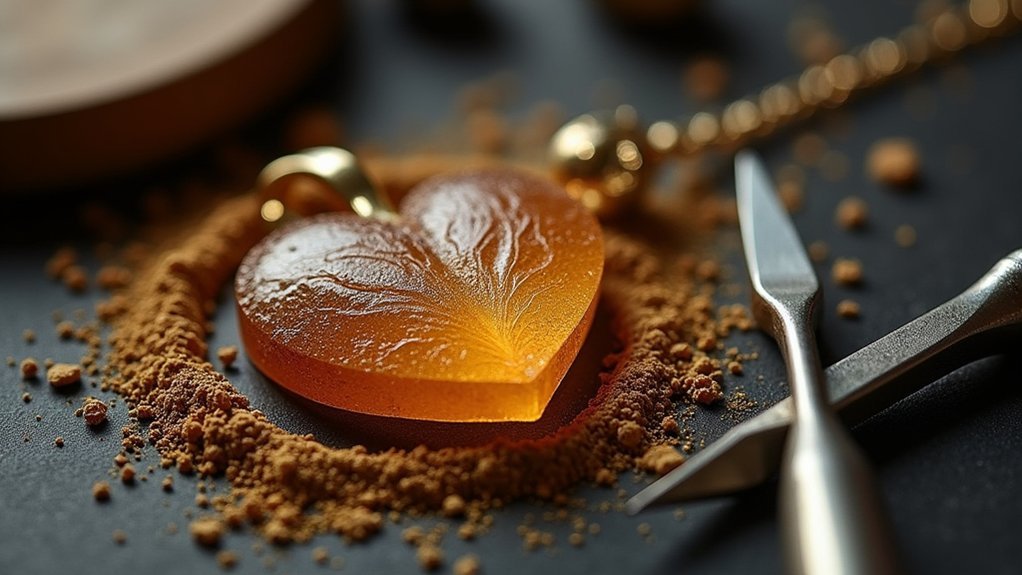
The lost wax casting method transforms your detailed wax models into stunning metal jewelry pieces through a time-tested process that’s captivated artisans for thousands of years.
Ancient artistry meets modern precision as molten metal breathes life into delicate wax sculptures through this timeless casting tradition.
You’ll start by creating intricate wax models using microcrystalline wax for flexibility or paraffin wax for hardness. Next, you’ll encase your model in refractory material to form a mold. When heated, the wax melts away, leaving a precise cavity ready for molten metal.
Using a crucible, you’ll melt your chosen alloy—gold, silver, or bronze—then pour it into the cavity. Once cooled, you’ll break apart the mold to reveal your cast piece.
This lost wax casting technique excels at capturing fine details that make jewelry making so rewarding, though you’ll need polishing for the final finish.
Sand Casting Technique
While lost wax casting excels at capturing intricate details, sand casting offers jewelry makers a more accessible and cost-effective approach to creating metal pieces.
You’ll create molds by mixing sand with a binder, enabling you to achieve impressive surface detail and intricate designs. Careful alignment of mold parts is essential—misalignment causes casting defects that’ll ruin your jewelry casting project.
You must incorporate air escape holes into your sand molds to prevent metal from escaping during pouring, ensuring complete fills.
Consider using delft clay for detailed molds that capture fine elements and allow multiple castings.
Sand casting accommodates various metals, making it versatile for small jewelry projects and larger applications.
Centrifugal Casting Process
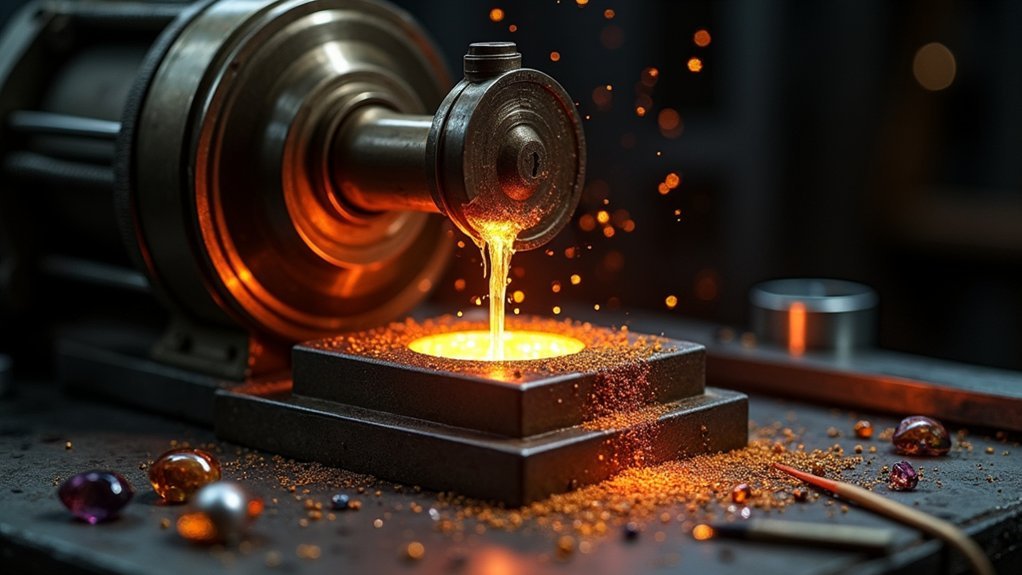
You’ll harness powerful centrifugal forces to push molten metal into every intricate detail of your jewelry molds with remarkable precision.
Your equipment setup requires a spinning arm or turntable that can achieve consistent high-speed rotation while safely containing the casting flask during operation.
You must master the timing and pouring technique to control metal flow effectively, ensuring the molten material fills completely before the spinning motion stops.
Centrifugal Force Mechanics
When molten metal enters your carefully prepared mold, centrifugal force becomes the driving mechanism that assures complete filling of even the most intricate design details.
This powerful force pushes your metal outward from the center, creating pressure that eliminates air pockets and assures dense, high-quality castings.
The mechanics work through controlled rotation speeds that jewelry makers can adjust based on their specific needs:
- RPM ranges from 300 to 3,000 depending on piece size and complexity
- Outward pressure forces metal into every mold detail and crevice
- Consistent distribution prevents weak spots or incomplete fills
- Air displacement occurs as centrifugal force pushes gases out
- Dense metal structure results from sustained pressure during solidification
Understanding these mechanics helps you optimize your metal casting results for superior jewelry pieces.
Equipment Setup Requirements
Setting up your centrifugal casting equipment correctly determines whether you’ll achieve professional-quality jewelry pieces or encounter costly failures.
You’ll need to secure your mold firmly in the rotating arm and align the metal pouring channel for ideal molten metal flow during the casting process. Choose graphite or ceramic crucibles that withstand high temperatures without compromising your molten metal’s integrity.
Your workspace must be fireproof with proper safety gear including gloves and goggles to protect against splashes and dangerous fumes.
Calibrate your machine’s rotation speed to match your specific metal’s viscosity requirements. Proper calibration guarantees the centrifugal force distributes molten metal evenly throughout your mold, creating flawless jewelry pieces every time.
Metal Flow Control
Three critical factors determine successful metal flow control in centrifugal casting: timing, temperature, and rotational force.
You’ll need to pour your molten metal immediately after melting to prevent premature solidification. This casting method relies on precise coordination between these elements to achieve complete cavity filling.
Your metal flow control success depends on:
- Quick pouring technique – Transfer molten metal within seconds of reaching proper temperature
- Optimal rotational speed – Adjust RPM based on your jewelry piece’s complexity and size
- Proper mold temperature – Preheat molds using quality refractory materials for consistent flow
- Consistent timing – Maintain steady rhythm from melting to pouring to spinning
- Flow path planning – Design sprues and gates to direct metal efficiently through intricate details
Mastering these variables guarantees uniform density and eliminates air pockets in your finished pieces.
Vacuum Casting System
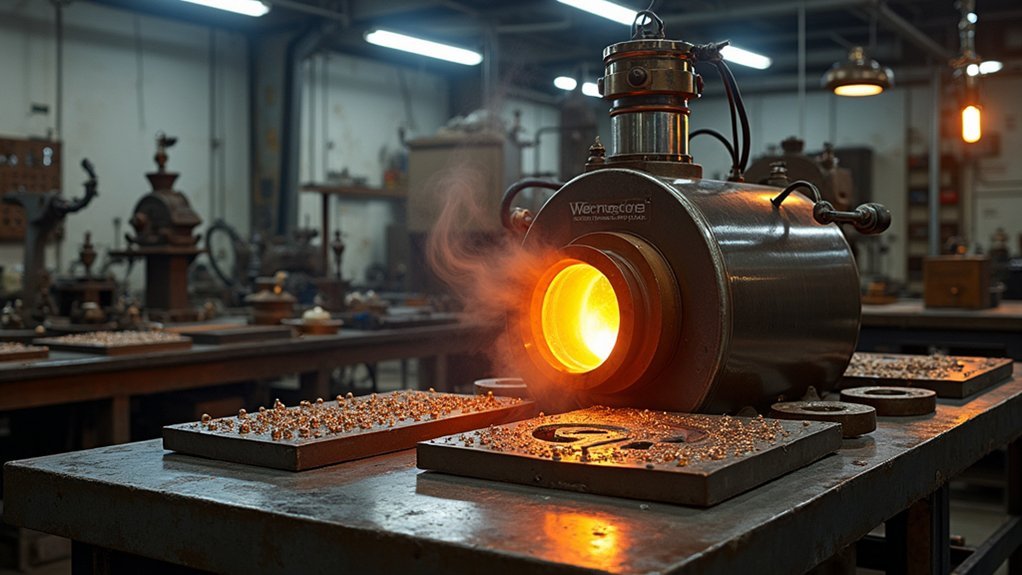
You’ll find vacuum casting systems revolutionize your metal casting by creating a negative pressure environment that dramatically improves mold filling.
The vacuum pump’s operation draws out air from the casting flask, allowing molten metal to flow smoothly into every detail of your mold cavity.
This process eliminates air bubbles that typically cause porosity and surface defects in your finished jewelry pieces.
Vacuum Pump Operation
When you’re operating a vacuum pump for jewelry casting, you’re fundamentally creating the ideal environment for molten metal to flow into every intricate detail of your mold.
This essential component in casting processes guarantees you’ll achieve professional-quality results by eliminating air bubbles that could compromise your finished piece.
Here’s what you need to know for proper vacuum pump operation:
- Maintain vacuum pressure between 25-30 inches of mercury for best metal flow
- Check all connections and seals before starting to prevent performance-damaging leaks
- Monitor the vacuum gauge continuously throughout the pouring process
- Keep the vacuum running for several minutes after pouring to guarantee complete mold filling
- Inspect your vacuum pump regularly to maintain consistent pressure levels for quality casts
Mold Filling Enhancement
Everything changes when you implement a vacuum casting system to enhance your mold filling capabilities. This technique transforms how molten metal flows into your mold cavities by reducing air pressure, allowing better penetration into intricate details.
| Benefit | Result |
|---|---|
| Reduced air pressure | Better metal flow |
| Eliminates air bubbles | Higher quality finish |
| Improved penetration | Accurate reproductions |
| Optimized metal usage | Reduced waste |
When you’re pouring molten metal under vacuum conditions, you’ll achieve superior results in thin sections where traditional gravity casting fails. The vacuum draws metal into every crevice of your mold, ensuring complete fills even in complex jewelry designs. While you’ll need additional equipment like vacuum chambers and pumps, the investment pays off through increased efficiency and exceptional casting quality.
Air Bubble Elimination
Air bubbles represent the primary enemy of quality jewelry casting, and vacuum systems attack this problem at its source by creating an environment where trapped air simply can’t exist.
Your vacuum casting setup eliminates these defects by drawing air from the mold before and during metal pouring, guaranteeing complete cavity filling.
Key benefits of vacuum casting for air bubble elimination:
- Pressure control – You’ll achieve 20-30 inches of mercury vacuum pressure for ideal results
- Enhanced detail – Metal flows smoothly into intricate mold designs without air interference
- Improved yield – Prevents incomplete fills that create costly scrap requiring remelting
- Consistent quality – Regular equipment maintenance guarantees reliable air bubble elimination performance
- Superior finish – Eliminates surface defects caused by trapped air pockets
This technology transforms your casting quality dramatically.
Investment Casting Procedure
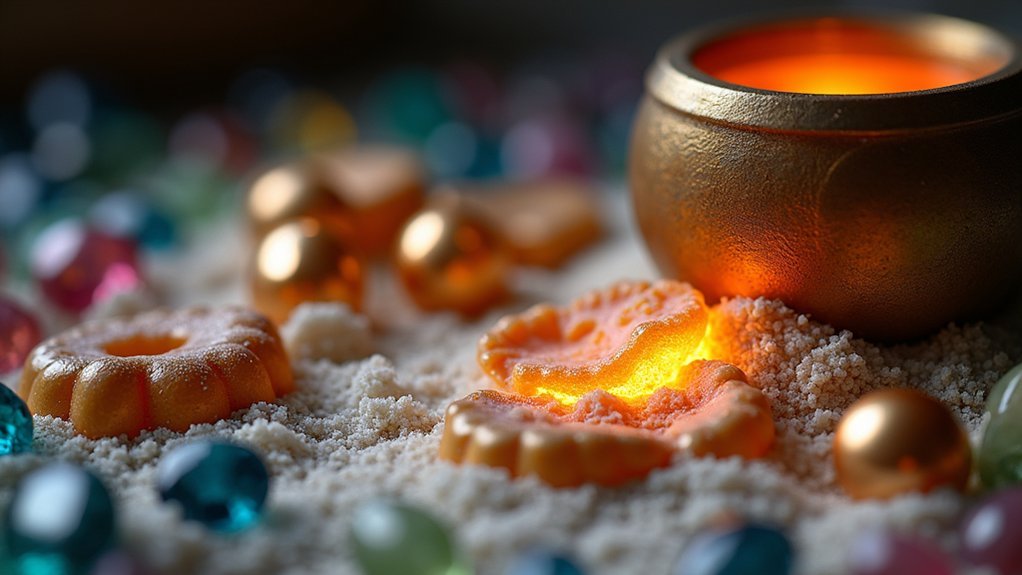
Five distinct steps comprise the investment casting procedure, transforming your wax model into a finished metal jewelry piece.
First, you’ll create detailed wax models that account for metal shrinkage and include sprues for proper flow.
Next, you’ll coat these models in a refractory plaster-silica mixture, building up layers to form a heat-resistant mold that captures intricate details.
Third, you’ll eliminate the wax by heating the mold in a kiln or microwave, creating hollow cavities.
Fourth, you’ll pour molten metal into these cavities, with your metal choice determining the piece’s final properties and appearance.
Finally, you’ll break away the investment mold and finish your cast jewelry through polishing and gemstone setting.
Cuttlefish Bone Casting
Cuttlefish bone casting offers jewelry makers an ancient yet accessible technique that transforms the natural skeletal structure of marine cephalopods into detailed casting molds.
You’ll carve or press your designs directly into the soft, pliable bone surface, creating intricate patterns perfect for making jewelry pieces.
This technique’s accessibility makes it ideal for small-scale projects where you need multiple castings from one mold:
- Incorporate air escape holes to prevent trapped metal during pouring
- Handle molds carefully to maximize reuse potential
- Take advantage of the bone’s natural texture for organic designs
- Work with molten metal that flows easily into carved details
- Create unique shapes that reflect the cuttlefish bone’s natural form
You’ll appreciate how this method produces distinctive, organic jewelry pieces.
Delft Clay Casting Method
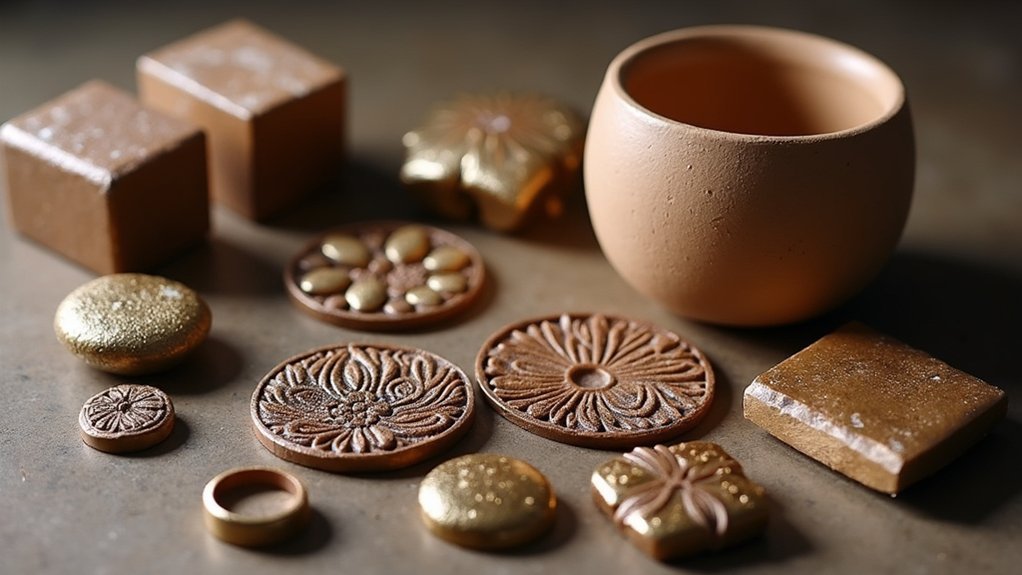
You’ll find that Delft clay casting offers exceptional versatility for creating detailed jewelry pieces through its unique sand-clay mixture.
Your success depends on three critical factors: properly preparing the casting sand to achieve the right consistency, aligning your mold halves precisely to prevent seam lines, and employing specific techniques to capture fine details in your designs.
These fundamentals will determine whether you produce professional-quality castings or encounter frustrating defects that waste both time and precious metals.
Sand Preparation Essentials
While many casting methods exist for jewelry making, Delft clay stands out as an exceptional choice for achieving intricate details in your pieces. The sand preparation process determines your casting success, requiring careful attention to mixture composition and consistency.
Your sand mixture should combine clay and fine sand to create ideal binding properties. This blend guarantees you’ll capture every detail while maintaining easy mold removal after metal casting.
Key preparation essentials include:
- Mix clay and fine sand in proper ratios for binding strength
- Achieve consistent texture throughout the entire mixture
- Test moisture content to prevent cracking during casting
- Sift materials to remove any lumps or debris
- Store prepared mixture in airtight containers for reuse
Proper preparation creates multiple successful castings from your initial investment.
Mold Alignment Techniques
Perfect alignment transforms your Delft clay mold from a promising start into a professional-quality casting. You’ll achieve precise mold alignment by inserting alignment pins or dowels into both halves before the casting process begins.
| Step | Action |
|---|---|
| 1 | Insert alignment pins through both mold halves |
| 2 | Apply release agent to all mold surfaces |
| 3 | Check for gaps or misalignments carefully |
| 4 | Secure mold halves before pouring metal |
Before pouring, inspect every seam for gaps that could cause defects. Release agents not only ease separation but help maintain proper positioning throughout the casting process. Once you’ve poured the metal, resist rushing the cooling phase. Adequate cooling time prevents warping and maintains the alignment you’ve worked to establish, ensuring your final piece captures every detail.
Detail Capture Methods
How can you guarantee your Delft clay mold captures every fine detail of your original model? Start by ensuring your clay mixture contains the right balance of fine clay and sand. Press your pattern firmly and evenly into the soft clay to create clear negative impressions.
The detail capture process requires these essential steps:
- Press steadily – Apply consistent pressure across the entire surface to avoid incomplete impressions.
- Check clay consistency – Use properly mixed delft clay that’s soft enough to capture details but firm enough to hold shape.
- Remove air bubbles – Tap the mold gently to eliminate trapped air that could create defects.
- Allow proper hardening time – Let the clay set completely before removing your original pattern.
- Test with molten metal – Pour carefully to create precise jewelry replications.
Steam Casting Technique
When you’re working with intricate jewelry designs that demand exceptional detail reproduction, steam casting offers a superior solution that harnesses steam pressure to drive molten metal into the finest mold features.
This technique creates a pressure differential that forces your molten metal deep into complex patterns, eliminating air pockets that compromise quality.
You’ll need specialized equipment to generate and direct steam into your casting chamber.
This enhanced flow dramatically improves mold penetration, especially for delicate pieces with thin sections or fine textures.
Temperature control becomes critical – you must maintain your metal’s molten state long enough for complete mold filling.
Steam casting provides an environmentally conscious advantage by reducing your reliance on fluxes and additional chemicals typically required in conventional methods.
Pressure Casting Process
Building on steam casting’s pressure principles, pressure casting takes metal flow control to the next level by applying sustained mechanical force—typically between 10 to 100 psi—to drive molten metal into every crevice of your mold.
You’ll achieve exceptional detail reproduction in intricate designs and thin-walled pieces using specialized machines that maintain consistent pressure throughout the casting process. This technique dramatically reduces air pockets and voids, giving you superior structural integrity.
- Force molten metal into complex geometries with sustained pressure
- Eliminate air bubbles and internal defects effectively
- Create thin-walled jewelry pieces with precise detail
- Maintain consistent pressure using specialized casting equipment
- Achieve professional-quality results with minimal porosity
After casting, you’ll need careful finishing to remove sprues and surface imperfections, ensuring your jewelry meets professional standards.
Tufa Stone Casting Method
While mechanical pressure systems deliver precision through technology, tufa stone casting embraces the artisan’s hand and nature’s own materials to create jewelry with unmatched organic character.
You’ll find this ancient technique uses naturally soft tufa stone that’s easily carved into intricate molds. Start by carving your design directly into the stone, then apply a release agent to guarantee clean removal later.
Carve your vision into soft tufa stone, creating intricate molds that capture every artistic detail with ancient precision.
When you pour molten silver metal into the carved cavity, it captures every detail while the stone’s porous texture creates distinctive surface qualities.
Tufa stone casting excels at producing unique textures and organic forms that give your jewelry a handcrafted appearance you can’t achieve with conventional casting methods.
Frequently Asked Questions
What Type of Casting Is Used for Jewelry?
You’ll primarily use lost wax casting for jewelry, as it captures intricate details perfectly. You can also choose sand casting, cuttlefish casting, or investment casting depending on your design complexity and desired finish quality.
What Are the Five-Five Metal Casting Processes?
You’ll use five primary metal casting processes: lost wax casting for fine details, sand casting for larger pieces, cuttlefish casting for textured finishes, die casting, and investment casting for precision work.
What Is the Best Casting Method?
You’ll find lost wax casting is the best method because it creates intricate designs with fine details. It provides exceptional accuracy and smooth finishes, making it ideal for complex jewelry pieces requiring precision.
What Is the Best Metal to Practice Jewelry?
You’ll want to start with silver since it’s malleable and affordable. Copper’s also excellent for practicing techniques without breaking your budget. These metals let you develop casting and finishing skills before investing in expensive gold.
In Summary
You’ve now explored nine powerful metal casting techniques that’ll transform your jewelry making. Each method offers unique advantages, from lost wax’s intricate detail to tufa stone’s organic textures. Don’t feel overwhelmed by the options—start with one technique that matches your current skill level and workspace. As you master each process, you’ll discover which methods work best for your creative vision and expand your metalworking capabilities considerably.

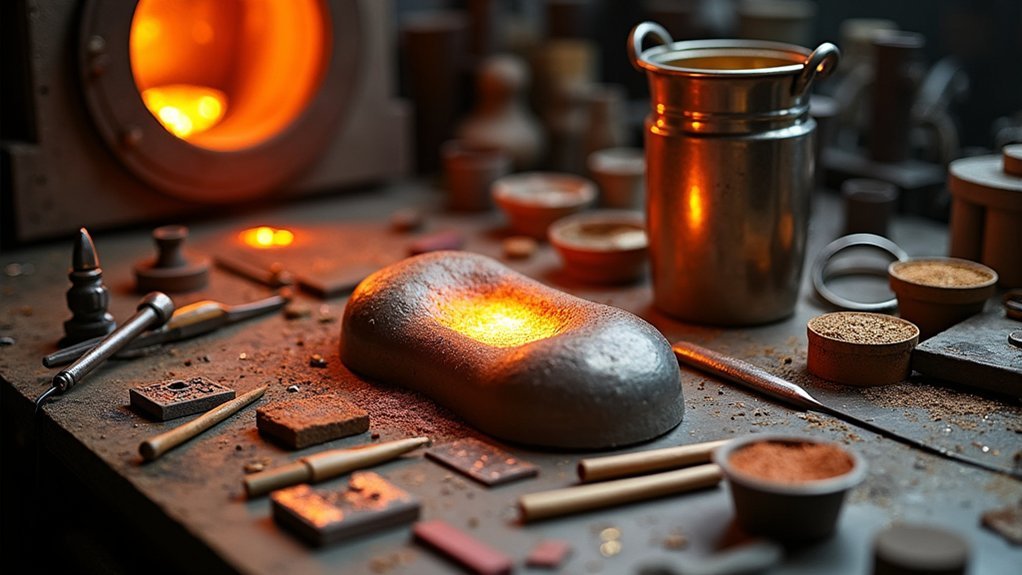

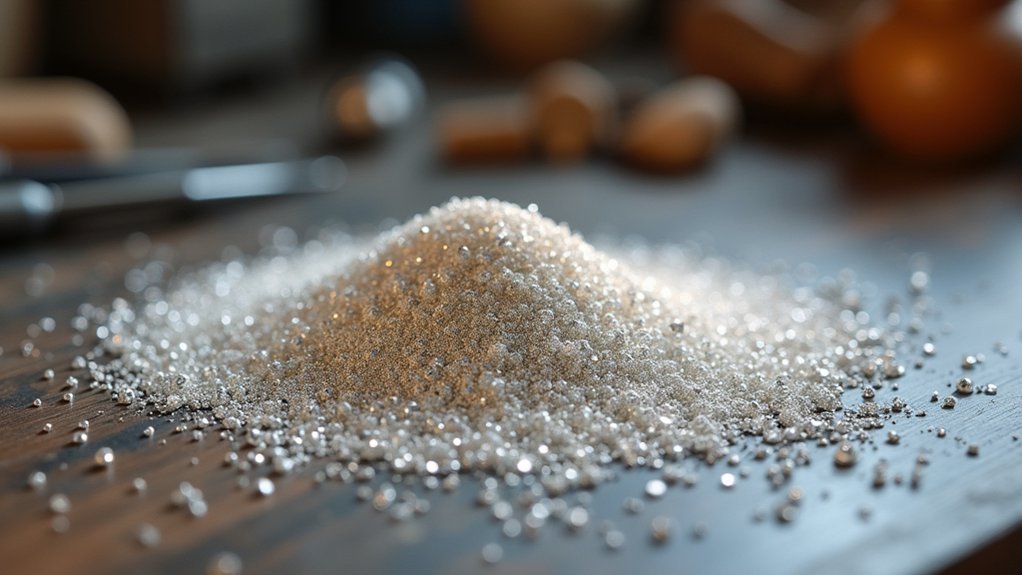
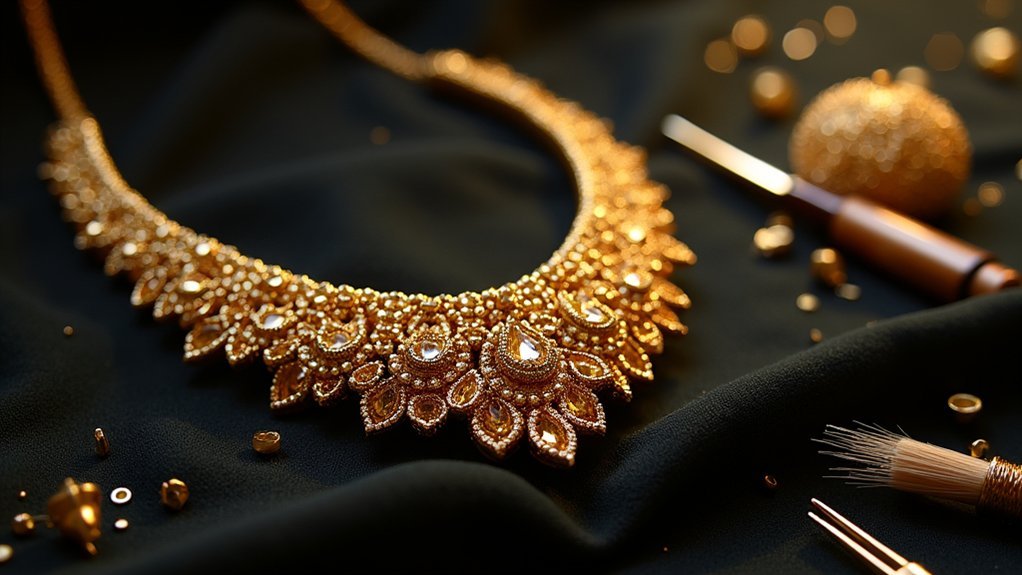
Leave a Reply